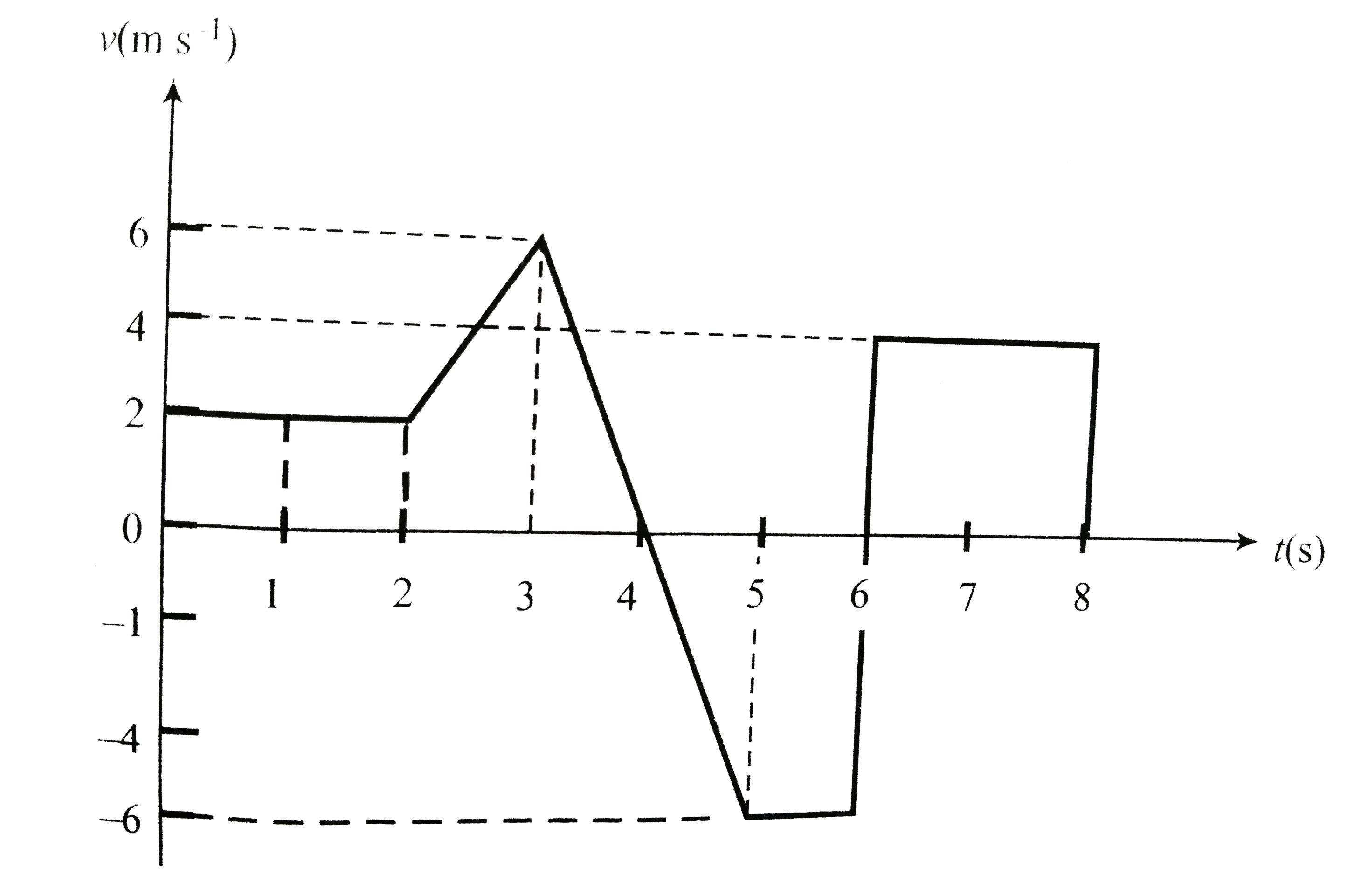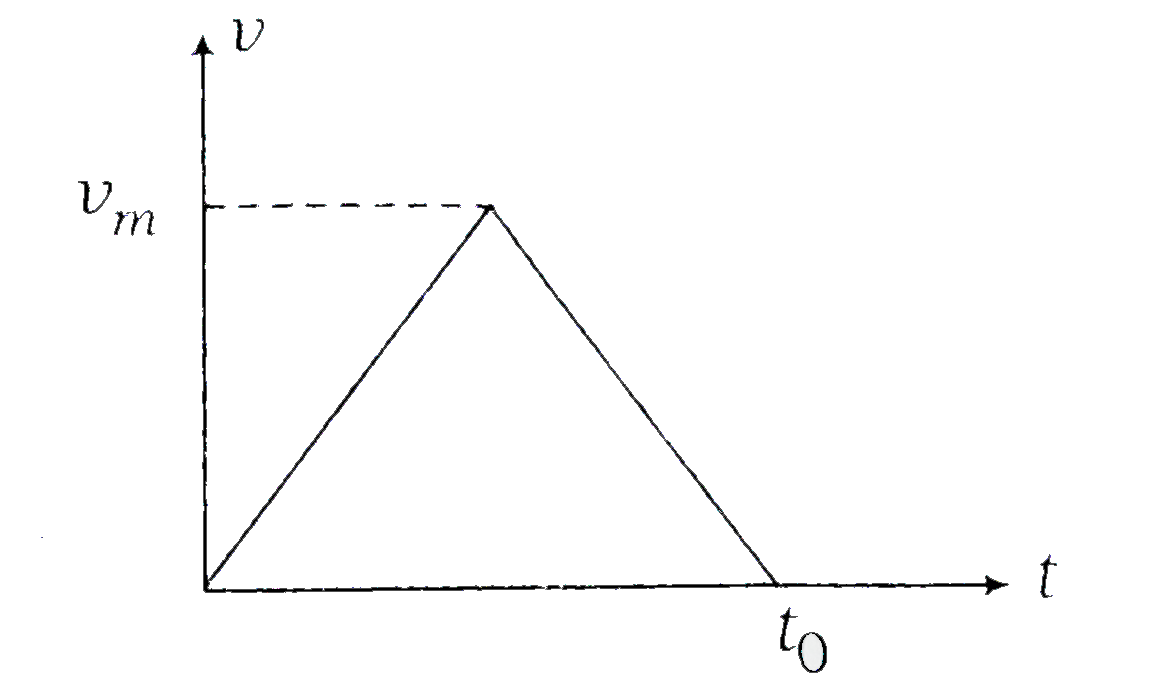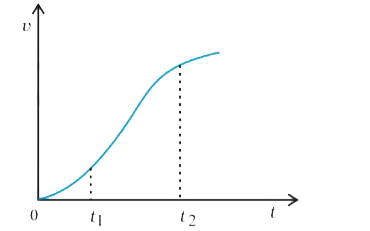A point move with uniform acceleration and υ1,υ2 and υ3 denote the average velocities in the three successive intervals of time t1,t2 and t3. which of the following relations is correct ?
(v1−v2):(v2−v3=(t1−t2:(t2+t3.
(v1−v2):(v2−v3=(t2−t2:(t2+t3
(v1−v2):(v2−v3=(t1−t2:(t2+t3
(v1−v2):(v2−v3=(t1−t2:(t2+t3
The correct Answer is:B
Suppose u be the initial velocity.
Velocity after time t1: v11=u+at1
Velocity after time t1+t2: v22=u+a(t1+t2
Velocity after time t1+t2+t3:
v3=u+a(t1+t2+t3)
Now v1=u+v112=u+u+at12=u+12at1
v2=v11+v222=u+at1+122
v3=v33+v332=u+at2+12at3
So v1−v2=−12a(t1+t2)
v2−v3=−12a(t2−t3)
(v1−v2): (v2−v3=(t1+t2) : (t2+t3).
Topper's Solved these Questions
- KINEMATICS-1Book:CENGAGE PHYSICS ENGLISHChapter:KINEMATICS-1Exercise:Graphical Concept
Explore 17 Videos
- KINEMATICS-1Book:CENGAGE PHYSICS ENGLISHChapter:KINEMATICS-1Exercise:Graphical cancept
Explore 1 Video
- KINEMATICS-1Book:CENGAGE PHYSICS ENGLISHChapter:KINEMATICS-1Exercise:Subjective
Explore 29 Videos
- GRAVITATIONBook:CENGAGE PHYSICS ENGLISHChapter:GRAVITATIONExercise:INTEGER_TYPE
Explore 1 Video
- KINEMATICS-2Book:CENGAGE PHYSICS ENGLISHChapter:KINEMATICS-2Exercise:Exercise Integer
Explore 9 Videos
Similar Questions
The velocity-time graph of a body is shown in .
The displacement of the body in 8s is.
 .
.
View SolutionThe acceleration will be positive in .

View SolutionA car moving with constant acceleration covered the distance between two points 60.0m apart in 6.00s. Its speed as it passes the second point was 15.0m/s.
(a) What is the speed at the first point?
(b) What is the acceleration?
(c) At what prior distance from the first was the car at rest?
View SolutionGravitational acceleration on the surface of a planet is √611g. where g is the gravitational acceleration on the surface of the earth. The average mass density of the planet is 23 times that of the earth. If the escape speed on the surface of the earht is taken to be 11kms−1 the escape speed on the surface of the planet in kms−1 will be
View SolutionA particle is projected with velocity u at angle θ with horizontal. Find the time when velocity vector is perpendicular to initial velocity vector.
View SolutionThree planets of same density have radii R_(1),R_(2) and R_(3) such that R_(1) = 2R_(2) = 3R_(3) . The gravitational field at their respective surfaces are g_(1), g_(2) and g_(3) and escape velocities from their surfeces are upsilon_(1),upsilon_(2) and upsilon_(3) , then
View SolutionA point moves with uniform acceleration and v1,v2, and v3 denote the average velocities in the three successive intervals of time t1.t2, and t3 Which of the following Relations is correct?.
View SolutionA stone of mass m tied to one end of a string is revolved in a vertical circle of radius R the net forces at the lowest (FL and highest (FH) points of the circle directed vertically downwards are :
(a) FL=mg−T1FH=mg+T2
(b) FL=mg+T1,FH=mg−T2
(c) FL=mg+T1−mυ21R,FH=mg−T2+mυ21R
(d) FL=mg−T1−mυ21R,FH=mg+T2+mυ12R
Choose corret alternative T1,υ1 denote the tension and speed at the lowest point T2,υ2 denote corresponding valuse at the highest point .
View SolutionAssertion : In the υ−t diagram as shown in figure, average velocity between the interval t = 0 and t=t0 is independent of t0

Reason : Average velocity in the given interval is 12υm.
View Solutionएक चौड़ी सुरंग में ताप लंबाई के साथ बदलता है और d लंबाई में समान दर से बदलता हुआ परम् ताप T1 से परम ताप T2 हो जाता है । 273 K पर ध्वनि का वेग υ0 है । ध्वनि को इस d दूरी तय करने में लगे समय को T1,T2, d तथा υ0 के पदों में निकाले । T1=280 K, T2=310 K, υ0=330ms−1 तथा d = 33 m के लिए इस समय की गणना करे ।
View SolutionA body moves with uniform acceleration. If v_(1), v_(2) and v_(3) be the average velocities in three successive intervals of time t_(1), t_(2) and t_(3) , then :
View SolutionThe velocity-time graph of a particle in one-dimensional motion is shown in Fig.

Which of the following formulae are correct for describing the motion of the particle over the time-interval t1 to t2 :
(a) x(t2)=x(t1)+υ(t1)(t2−t1)+(1/2)a(t2−t1)2
(b) υ(t2)=υ(t1)+a(t2−t1)
(c ) υaverage=(x(t2)−x(t1))/(t2−t1)
(d) aaverage=(υ(t2)−υ(t1))/(t2−t1)
(e ) x(t2)=x(t1)+υaverage(t2−t1)+(1/2)aaverage(t2−t1)2
(f) x(t2)−x(t1)= area under the υ−t curve bounded by the t-axis and the dotted line shown.
View SolutionThe velocity-time graph of a particle in one-dimensional motion is shown in Fig.

Which of the following formulae are correct for describing the motion of the particle over the time-interval t1 to t2 :
(a) x(t2)=x(t1)+υ(t1)(t2−t1)+(1/2)a(t2−t1)2
(b) υ(t2)=υ(t1)+a(t2−t1)
(c ) υaverage=(x(t2)−x(t1))/(t2−t1)
(d) aaverage=(υ(t2)−υ(t1))/(t2−t1)
(e ) x(t2)=x(t1)+υaverage(t2−t1)+(1/2)aaverage(t2−t1)2
(f) x(t2)−x(t1)= area under the υ−t curve bounded by the t-axis and the dotted line shown.
View SolutionProve that the point of intersection of the tangents at t1andt2 on the parabola y2=4ax is (at1t2,a(t1+t2))
View Solutionएक समान त्वरण के साथ गतिमान एक कण के औसत वेग, v एवं क्रमिक समयान्तरालों क्रमशः t1,t2, t3 पर दिए गए है |(v1−v2)(v2−v3) का मान होगा
View SolutionA point moves with uniform acceleration and v_(1), v_(2) And v_(3) Any successive periods: t_(1),t_(2) or t_(3)
View Solution
